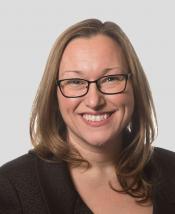Casie Davidson
Countries around the world are driving ahead with renewable energy to reduce planet-warming greenhouse gas emissions. Still, existing and new fossil power plants and difficult-to-electrify industrial facilities will continue to operate well into the middle of this century. Capturing carbon dioxide (CO2) and preventing it from ever entering the atmosphere is increasingly regarded as crucial to achieving a net zero energy future.
Casie Davidson is leading the way on CO2 capture and storage technologies to see that carbon stored underground stays put. “We’re seeing consensus across the research community that CCS technologies are essential to meeting climate goals in both the developed and developing world,” Davidson said. “CCS allows us to reduce emissions while buying us time to mature critical technologies like grid-scale energy storage.”
The story is far from over once the CO2 is captured. “Whether you capture it from a power, steel or ethanol plant—or the atmosphere itself—you have to do something with it,” Davidson said. She and colleagues are also working to close the carbon cycle by transforming captured CO2 into commodities like building materials and fuels. “At the end of the day though, all but a tiny fraction will need to be stored underground.”
As a geologist and an economist, Davidson navigates among key disciplines required to advance carbon capture and storage: engineering, economics, geology, and policy. She led a 2017 study that found carbon capture could cut the cost of meeting Paris climate agreement emissions targets in half, providing cost-effective options for reducing CO2 emissions until energy storage and widespread electrification are ready for primetime. “There’s no silver bullet for climate change,” Davidson said. “But fighting it with carbon capture and storage in our tool kit could double the value of all our other climate investments, which just might make the difference.”

